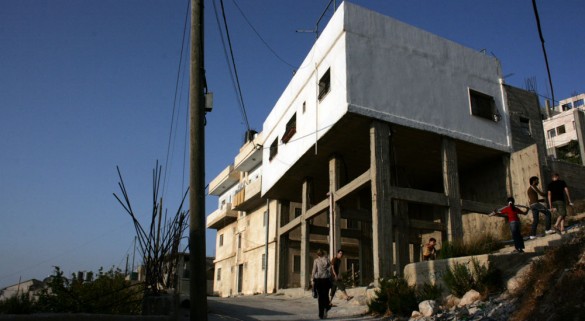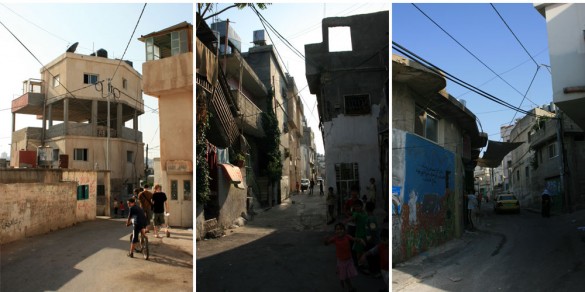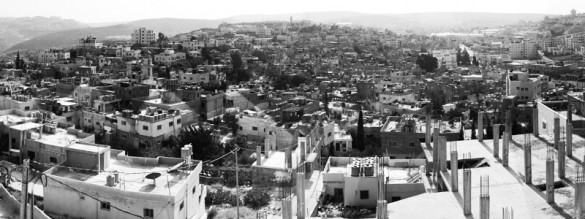by Nasser Abourahme and Sandi Hilal
An extract from the forthcoming article: “Political Subjectification, the Production of Space and the Folding of Polarity: the case of Deheishe Camp, Palestine” in James Holston and Teresa Caldeira (eds.) Peripheries: Decentering Urban Theory, University of California Berkeley Press.
(Republished on arenaofspeculation.org with permission from the authors.)

In discussing the democratic insurgency of working classes in Sao Paulo (Brazil) James Holston(1) identifies the self-construction or auto-construction of the city’s peripheries, of its houses, neighborhoods and urban life as a fundamental variable. Urbanization, he writes, transformed the working classes and “autoconstruction turned the peripheries into spaces of alternative futures, produced in the experience of becoming propertied, organizing social movements, participating in consumer markets, and making aesthetic judgments about house transformations.”(2) The struggle for dignified and secure tenure was, then, also a process of political becoming – a battle for substantive citizenship. One can extend aspects of this analysis to Dheisheh refugee camp. Apart from historically limited and contained UNRWA interventions in the built environment, refugees have had to construct many of their own houses, pave their own roads, organize and deliver most of their basic services, upgrade and maintain their own infrastructure, and build and run their own institutions and recreational venues. The camp’s built environment is in some ways in constant motion – perhaps best visually captured by the metal wires that sprout out of so many rooftops restlessly awaiting the next layer of concrete flooring. This is not without political and legal ramifications. De jure all houses in the camp are the property of UNRWA as leaseholder of the land. In this context the expansion of houses and their personalization is, in a similar vein, if a different legal equation, to that of Sao Paulo’s peripheries: a means of claiming property, of shifting the benchmarks of legal ownership, and of contesting control.
The difference in contexts – aside from the obvious fact that without a representative state, the idea of citizens’ struggle (in the classic sense of reconfiguring state–society relations) is largely meaningless – lies in the fact that urbanization here carries inherent political pitfalls. Urbanization and improvement have been for large periods and with some justification perceived as thinly veiled attempts at integrating refugees and undermining their claims to the ‘right of return’. This association is worth explaining: the right of return, as the ground and horizon of liberation, is affirmed in the continued existence of the camp. The camp is the living memory or archive of displacement; it is both the marker of dispossession and the means to its resolution. The memory of the catastrophe (al-nakba) and its sequential connection to the present is expressed in the precariousness and transience of the camp’s appearance: exposed sewage, bricolage housing, unplanned growth.(3) Improving and ‘diluting’ the camp, blending or integrating it into the surrounding landscape so that it loses its spatial discernability is seen as an attempt to short-circuit these connections; an attempt to ‘de-camp’ the camp and dissolve refugee identity.


In the early days of the occupation, as part of initiatives aimed at permanently resettling Palestinian refugees in the West Bank, the Israeli Civil Administration itself drew up plans for the urban reform of the camps and was ready to finance them. These were rejected and efforts exerted in maintaining the visual, architectural and social markers that demarcate the camp’s specificity as a camp. Whilst official differentiation in Sao Paulo (in rights, legal status, access to land) fueled insurgency that ended up disrupting, if also partially reproducing, these differentiations(4) in Dheisheh, as in other Palestinian refugee camps, differentiation is something that is in large part self-ascribed.(5) The tension between equalizing access and rights and maintaining some fundamental differentiation is extremely complex and immanently palpable. The political stakes whether real or imagined are high. This has in part reinforced an existential culture or paradigm of ‘permanent temporariness’, what Bauman has called the ‘frozen transience’ of refugeehood(6) Abu Khalil al-Laham, a leading community figure involved in Dheisheh’s Popular Committee talks of the stifling effects of this kind of mind-state; Dheisheh he says was:
“A society that resisted change, a society stuck in a culture of exile – ‘this is not my house’ is what people would say – a society stuck in temporariness; but temporariness kills creativity, it kills and prevents initiative…political and social awareness, our general cultural awareness was inhabited by a culture of temporariness that prevented societal development…you can not plan tomorrow if you live in a state of transit”(7) [emphasis ours].
Herein lies the profoundness and novelty of what Deheishans have been able to do. Dheisheh (and following its lead other camps in the West Bank) has been able to negotiate this impasse/contradiction by defining and articulating urban and spatial improvement – which has conventionally been viewed as a political trap – as a means of strengthening political struggle. In effect, turning the equation on its head. Abu Khalil again: “We fought the temporary. Today we are in the here and now. To have presence, to have factories, to have institutions doesn’t negate our role or our rights as stipulated by international legitimacy. On the contrary!”(8)
Deheishans have done this by explicitly linking urban improvement to the creation of new political space for agency. This marks a serious shift in the way Palestinian refugees interpret and instrumentalize the spaces of their camps. There is a conscious effort to distinguish between the political and legal rights of displaced people and their social and environmental living conditions; or in other words to insist on a political rather than socio-economic definition of refugeehood. In this, rejection of ‘need’ as a constitutive principle of rights, Dheishens began to negotiate a path in between the strange complicity of those who want to improve the camp as a means of undermining the right of return and those who reject any improvement to reinforce the very same claims to return. Improvement, in this context, becomes a process by which refugees forge the contours or the possibilities of the contours of political space by obviating the exigencies of fragile and precarious material life. In her writing on Shu’fat Camp just outside Jerusalem, sociologist Sylvaine Bulle writes that the ‘domestication’ of the built environment (her term for the humanizing urbanization of the camps), while at some level contrasts with the political face of the camps as a place of resistance, has consequences in the public domain and sphere.(9) These practices transform the “universe of enclosure into one of intimacy, safety and sometimes into some form of common good…they appear to legitimize the environment, its potential and creativity.”(10) Self-urbanization, then, can be read as a struggle for recognition
that connects the private scale with political and collective concerns through the production of the fabric of a livable environment and not through the lobbying of public institutions. In this sense, she goes on, the camp, is posed not only as a refuge but as a space of temporal experiences, open to appropriation.(11)

Endnotes
1. Holston, J., Insurgent Citizenship: Disjunctions of Democracy and Modernity in Brazil (Princeton: Princeton University Press) 2008.
2. Ibid: 8.
3. Sivan E. “On the Palestinian Refugee Camp as a ‘Permanent-Temporary’ Solution Regime” in Arxipelag d’Exceptions CCCB, Barcelona, Spain. 2007. p.154.
4. Holston 2008: 166.
5. Of course refugees are also differentiated by urban and rural Palestinian society; the point is that differentiation in this context is multivalent some of it coming from the refugees themselves.
6. Bauman, Z. Liquid Times (London: Polity), 2007. p. 46.
7. Al-Laham, Abu Khalil. Founder of Dheisheh’s Popular Committee, member of the Palestinian Legislative Council and prominent political figure [interview by N. Abourahme and S. Hilal] Dheisheh Camp, 5 October 2008.
8. Ibid.
9. Bulle, S. “From Domination Towards Decency: trends and paradigms in Jerusalem and the Palestinian territories in recent years.” Paper presented at the Museum of Petah Tikva, October 2008. p.11.
10. Ibid.
11. Cited in Hijazi, S. Paper presented at conference ‘Territoriality, Temporality and Identity’ Held 15-16 October 2008 Roskilde University, Copenhagen p.4.
Interviews and Focus Groups:
Odeh, Naji. Member of Dheisheh’s Popular Committee and community activist [interview by N. Abourahme and S. Hilal] Dheisheh Camp, 13 August 2008.
Focus Group Meeting (mixed men and women) al-Finiq Centre, Deheish Camp 10 August 2008.
Focus Group Meeting (girls aged 9-14) Women’s Program Centre, Dheisheh Camp 4 October 2008.
